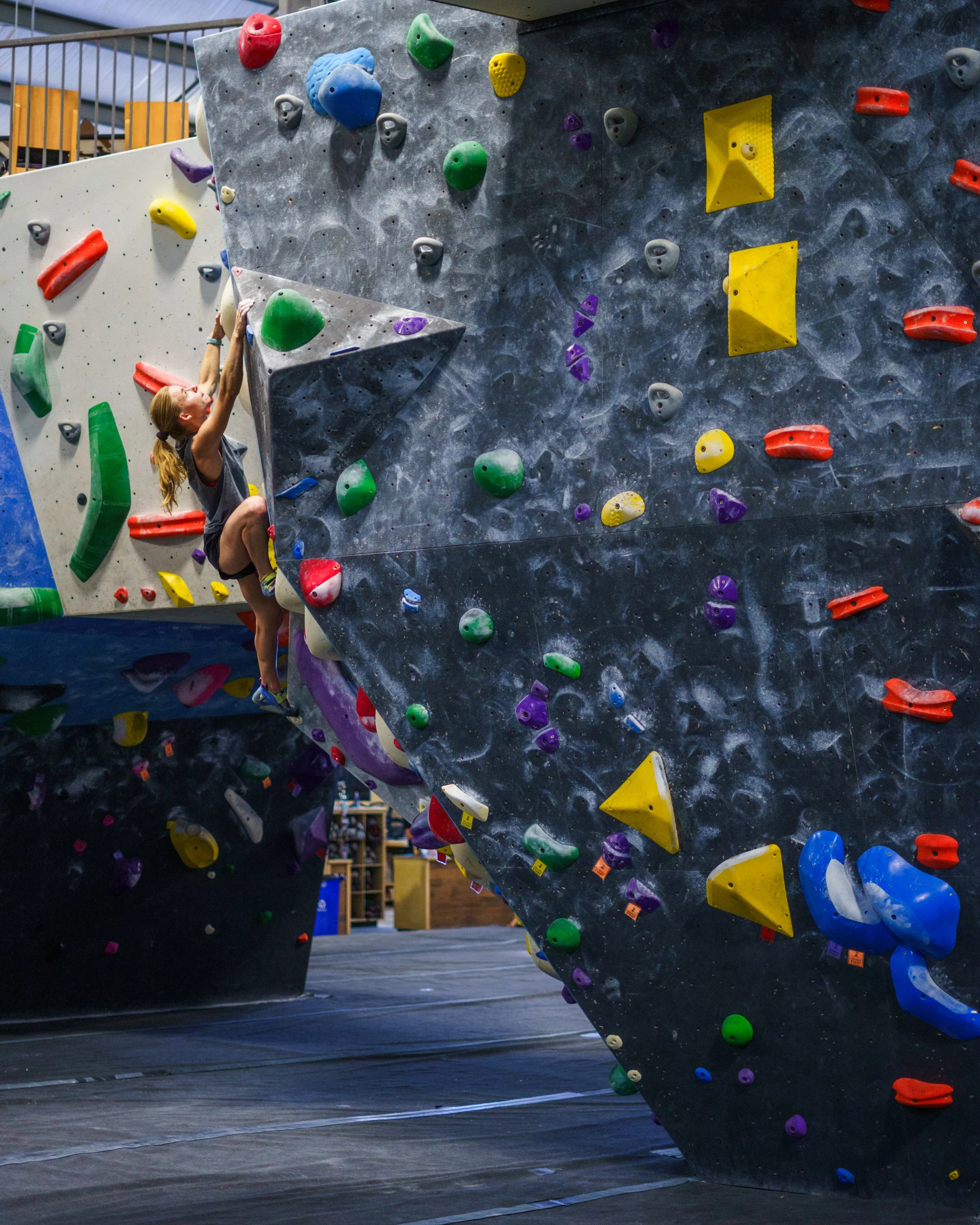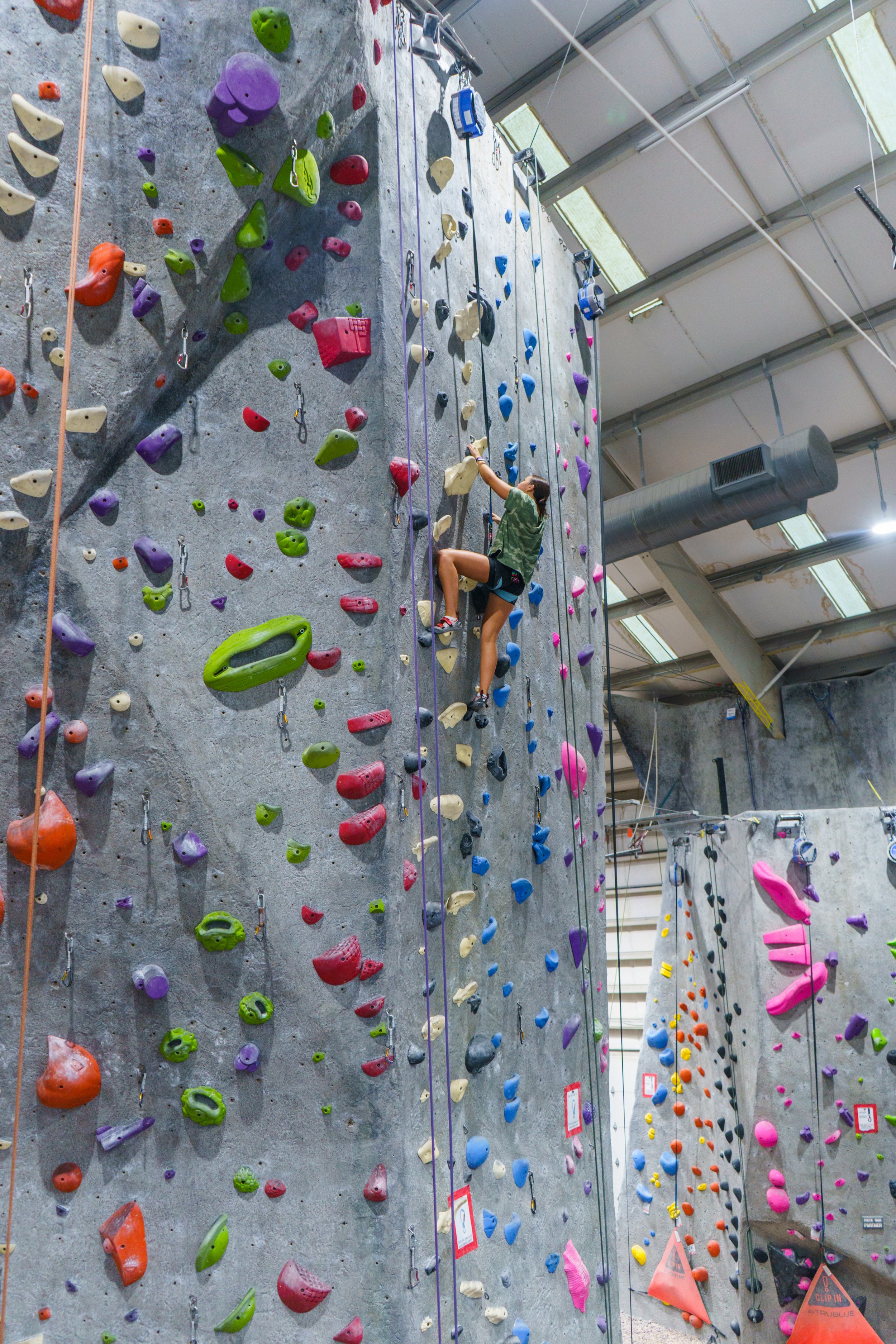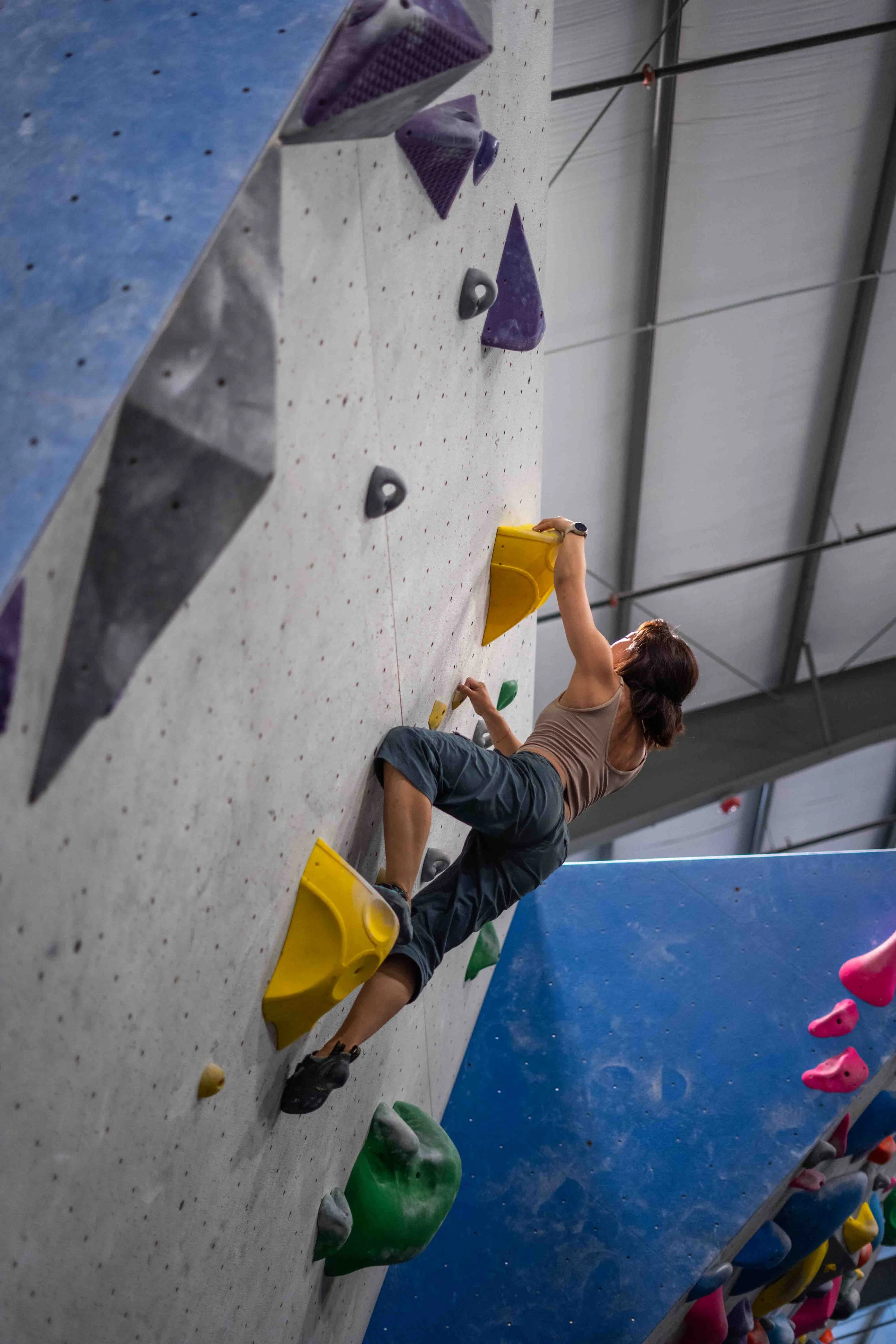
NEWS
A First Time Climber’s Guide to Everything
We believe climbing is for everyone. After all, if you can climb a ladder, you can scale a wall. However, we get that trying out a new kind of adventure can be a little nerve-wracking. Whether you've decided to take your first steps into the world of indoor climbing or are contemplating the idea, welcome! You’re in the right place.
Here at Peak Experiences, we believe climbing is for everyone.
After all, if you can climb a ladder, you can scale a wall. However, we get that trying out a new kind of adventure can be a little nerve-wracking. Whether you've decided to take your first steps into the world of indoor climbing or are contemplating the idea, welcome! You’re in the right place.
But fear not! Our friendly staff can guide you through everything you need to know, and teach you how to manage the risks of climbing, and your fears too. So, let's strap on our climbing shoes, chalk up our hands, and dive into the excitement of our favorite sport!
If you get to the end of this blog post and still aren’t sure where to start, our Climbing Sampler might be perfect for you!
No, seriously, climbing is for everyone.
All ages, sizes, and ability levels are welcome in climbing. We have a wide variety of route difficulties, with a handy bouldering grade chart available in our gyms to let you know the difficulty level of the route you’re eyeing. We have routes that are as simple as a ladder, ones you can try once you’ve got a hang of things, and ones that pose a serious challenge to anyone who attempts them.
Climbing isn’t all about upper body strength. No pull-ups necessary! Climbing is a puzzle on the wall you solve with your body – it requires a combination of body awareness, core tension, grip strength, leg strength, and yes, some upper body strength to get you up the wall. Practice is the key to “sending” (finishing) your route.
Community is the core of the sport. You’ll build trust and communication skills when you spend time climbing with a partner. It’s also very normal to talk to and encourage your fellow climbers in the gym! You’ll meet the friendliest people inside Peak, happy to give advice if you’re looking for it.
What to Expect
Lots of lingo. Sometimes it sounds like climbers are speaking their own language, but you’ll figure it out quickly. Most of the time, people will know what you’re talking about. It’s perfectly fine to call a donut-shaped hold a donut, instead of a pocket or a hueco. Check out our Glossary for Climbers to see if you can pick up a couple words!
Climbs that will challenge you: we have a wide range of difficulty levels for a reason. You’ll gain confidence from the progress you’ll make on routes that are hard for you.
Some serious soreness. Climbing requires the use of muscles you probably have never used so specifically. It’s perfectly normal to have sore muscles and some raw skin on your hands after a climbing session.
What You Need to Bring
A completed Assumption of Risks Form! Everyone who comes into our gym needs to fill out this form, regardless of participation level. We don’t charge entry to folks who are just watching.
Show up in comfy clothes, ready to move. Sweatpants, athletic pants, leggings, t-shirts, and tank tops work just fine. You’ll probably want to wear long pants; our walls are very textured, just like sandstone would be outside. Loose-fitting clothing or jewelry (especially rings) can get caught on climbing holds or ropes, so leave those at home. Short nails also make gripping holds easier.
We have climbing shoes and harnesses available to rent, but you’re welcome to wear closed-toe, snug-fitting athletic shoes if you’d prefer not to rent shoes.A reusable water bottle. We have water coolers for you to fill your bottle from, but can’t guarantee our supply of paper cups won’t run out.
All About Indoor Climbing
There’s a lot that goes into indoor climbing, and we know that it can be overwhelming to figure out at first, so we put together this guide for anyone looking to get started in the great indoors.
There are no age or weight restrictions to try out climbing. We have a variety of equipment that can fit all shapes and sizes. If you can climb a ladder, you can climb at Peak Experiences!
the basics for new climbers
There’s a lot that goes into indoor climbing, and we know that it can be overwhelming to figure out at first, so we put together this guide for anyone looking to get started in the great indoors.
There are no age or weight restrictions to try out climbing. We have a variety of equipment that can fit all shapes and sizes. If you can climb a ladder, you can climb at Peak Experiences!
At Peak, we do not require a certification to climb, but our roped-climbing belay systems require certifications. We can provide you with both instruction and any necessary certifications!
Here at Peak Experiences, we offer a few types of climbing
Bouldering, which is climbing on our shorter walls over padded flooring. Bouldering does not require a harness or a rope.
Roped climbing, which is climbing our taller walls while tied into a harness and another individual takes up the rope slack as you climb, catches you if you fall, and lowers you to the ground.
Auto belay, which is climbing our taller walls, while attached to a device that will catch you and lower you to the ground.
Bouldering
We offer bouldering at both of our locations, Peak Midlo and Peak RVA, though the areas look a little different.
To ‘Start’ a “boulder problem”, you look for the tag(s) that indicate the grade of a boulder. There may be more than one start hold and tag for that route, and if that is the case, one hand must be on each hold. If there is just one, both hands must be on the start hold. From there you follow the holds of the same color to the top. The ‘top’ of a boulder at Peak RVA is the highest hold of that boulder problem. At Peak Midlo, it’s the numbered section of the top of the wall, indicated on the start tag(s) of that boulder problem.
The only equipment you need to boulder is climbing shoes, which we have available to rent in a wide range of sizes, but if you’d like to climb a little higher, we have hundreds of rope routes to climb, and harnesses to rent as well
Roped Climbing
Roped climbing refers to routes on the tall walls in the gym, for which climbers must use a harness and a rope system to ascend the wall. Between our two locations, we have many dozens of climbs of a variety of difficulties available for you to try! First time climbers will likely be climbing routes using our double-wrapped top-rope system, in which the climber’s harness is attached to a rope that is wrapped twice around a reinforced steel ‘belay bar’ at the top of the route.
There’s also an advanced type of climbing called Lead Climbing, or Sport Climbing, where the climber ascends the wall with a rope attached to their harness, and the climber clips the rope into bolts that are in the wall along the route.
We offer a Learn the Ropes class if you’d like to learn the safety systems for roped climbing, but no experience is required if you’d like to use our auto-belay systems.
Auto Belay Devices
Auto Belays are devices that are attached at the top of the route and clipped into a climber’s harness. When a climber falls while climbing a route, the device is able to ‘catch’ them gently and lower them slowly to the ground.
They’re awesome for many reasons! You don’t need a climbing partner to use an auto-belay, and you don’t need to know how to tie a knot or use a belay device. This makes them perfect for first time climbers, but experienced climbers love them too. You can repeat routes as many times in a row as you’d like, which helps to build endurance and strength.
Auto-belay sound good for you? We require those using the Auto-Belay device to watch a video and pass a test for certification. Click here to watch our Auto Belay Video and learn more!
What is an Auto Belay?
climbing’s latest innovation: auto-belays
Auto Belays are great tools that allow participants to climb “roped” walls without a human belayer. Instead, the climber clips into the auto belay device, which connects to the top of the wall. If the climber falls or finishes the climb, the device is able to ‘catch’ them gently and lower them slowly to the ground.
Here at Peak Experiences, we have 20 Auto-Belays between our two locations, giving climbers access to more than 2 dozen routes without the need for a belayer. Our team of routesetters makes sure to put up routes accessible to all levels of climbers across our gyms, but also focuses on simpler routes where the Auto-Belays are hung.
Why are Auto-Belays great?
They’re simple to use
Climbers don’t need to learn how to tie a knot, or use a belay-device to be able to use an Auto-Belay Device. We just require certification in order to use these devices, which is a quick process! Scroll to the end of this article to watch our informative video about Auto Belays. When you’re ready to take the next step, ask one of our front desk staff to test you, which is a quick 10-minute-or-less process.
You don’t need a climbing partner
Climbing is all about community… until your climbing partner bails, again! An auto-belay device will never leave ‘ya hangin’.
You can use them for endurance workouts
It’s impolite to make your climbing partner belay you up and down a route 10 times, in your quest to build climbing endurance. However, an Auto-Belay device won’t complain. Just make sure you’re giving the other climbers in the gym their turn as well!
Watch our Auto Belay Video
Group Auto-Belay Passes
Auto-belays are the perfect way to introduce a group of folks to the world of indoor climbing. We offer discounted day-passes for groups that come in together to use our Auto-Belay Devices, with a minimum of 6 people to qualify.
Click the button below to go to our Group Auto-Belay Page and book a group pass.
A Climber's Glossary
Climbing has a ton of terms and slang! It can make coming into the gym pretty intimidating for a new climber – which is why we put together this handy glossary of common climbing lingo.
Climbing has a lot of Jargon
Are you ready to embark on an exhilarating journey into the vertical world? Whether you're lured by the rugged beauty of nature's rock formations or intrigued by the challenging walls of an indoor gym, climbing pushes your limits and rewards you with an incredible sense of accomplishment.
But hold on a sec! Before you grab your trusty harness and lace up those sticky-soled shoes, let's make sure you're equipped with the expansive lingo of the climbing community. Fear not, my fellow new climbers, because today we're going to dive into a crash course on climbing terms. Consider it your secret code to unlocking the vertical playground!
An incomplete list of basic climbing terms
Arete
Derived from the French word for "ridge", an arete is an outer corner that can be used as a hand hold.
Belay
The act of controlling the rope for the climber, providing tension and catching them in case of a fall.
Bouldering
A style of climbing done on lower heights without ropes, making use of crash pads or a mat for protection. Here at Peak we have 16ft bouldering walls at Peak RVA and 8ft walls at Peak Midlo! Come in and try the two different styles!
Carabiner
A metal loop with a spring-loaded gate used to connect climbing equipment, such as ropes and harnesses.
Crag
A small or large outdoor climbing area with multiple climbing routes.
Crimp
A type of handhold or grip that requires using only the fingertips to grasp a small edge.
Crux
The most difficult or challenging section of a climbing route.
Dihedral
The inside of a corner – where two walls meet.
Drop-Knee
A technique where one knee is dropped down and pressed against the wall to create balance and reach. The key to reach is keeping your hips into the wall, and a drop-knee can help get one hip close into the wall.
Dynamic Rope
A stretchable rope used for absorbing the impact of a fall.
Dyno
A dynamic move that involves jumping or leaping to a distant hold.
Flag
Extending one leg to the side or back to maintain balance and prevent swinging. Think of it like using your leg the way a monkey uses their tail; shifting bodyweight to create balance.
Gaston
A type of hand movement that mimics opening two elevator doors, creating pressure outward.
GriGri
A popular brand of belay device that uses assisted braking to help catch a falling climber.
Heel Hook
Placing the heel of the foot on a hold to pull or push against it. The key to a good heel hook is to point your toes down, creating tension in the hip and allowing you to use that tension to draw yourself into and up the wall.
Lead Climbing
A style of climbing where the climber ascends while attaching the rope to protection points along the route.
Mantle
A move where the climber uses their arms and hands to push down on a ledge or hold and bring their body up onto it.
Quickdraw
A set of two carabiners connected by a sturdy sling used to attach the rope to protection points.
Route
A predetermined path or line established by climbers to ascend a specific rock or wall.
Slab
A climbing surface that is less than vertical, often characterized by smooth and friction-dependent movements.
Smear
Pressing the sole of the climbing shoe against the wall to gain friction and support, as opposed to using a defined foot hold.
Stem
Using opposing pressure between two surfaces to maintain balance and move upward.
Rock-over
Shifting weight from one foot to the other while using leverage to move the body upward.
Top Rope
A climbing technique where the rope is anchored at the top of the route and runs through an anchor point, providing protection from above.
Toe Hook
Hooking the front part of the climbing shoe, your toes, onto a hold to gain leverage.
Undercling
A handhold that is grasped from underneath, with the palm facing upwards.









